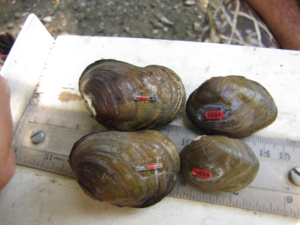
tags. Photo by Jeremy Tiemann, INHS
Historically, Illinois rivers supported approximately 80 species of freshwater mussels. Scientists estimate that 17 of those species have been extirpated (5 of which are globally extinct), including the northern riffleshell (Epioblasma rangiana). Last seen in Illinois over 100 years ago, the riffleshell was listed as federally endangered under the Endangered Species Protection Act in 1994.
Found in the shallow, oxygen-rich riffles of medium and large rivers, northern riffleshells bury themselves fully or partially in the gravel or sand bottom, leaving their “siphons” exposed. A muscular “foot” holds the mussel in place but can also be used to move through the substrate. Water is pumped in through the incurrent or branchial aperture and out through the excurrent or anal aperture. Food particles, including detritus (organic debris formed from the decay of organisms) and plankton (small floating plants and animals) are filtered from the water.
Reproduction
Males release sperm into the water, which is taken in by females downstream. Eggs are fertilized internally and stored in a brood pouch (marsupium) located in the female’s gills. After the eggs develop into the larval glochidia stage, the female northern riffleshell uses a lure to attract a fish to serve as a host, (e.g., darter or sculpin) to complete its life cycle. The female grabs the fish by the head and transfers the larvae into the fish’s mouth. The larvae attach to the gills of the fish where they remain until they grow shells of their own and drop into the sediment.
The first part of the shell formed is the umbo or beak, which is the dorsal margin of the adult shell. The mantle (the soft tissue that surrounds the body) secretes calcium carbonate to form the hard shell throughout its life. Northern riffleshells are small, up to 2 inches in length, yellowish brown or green with two ridges separated by a sulcus (shallow depression). On the posterior end, males have a sulcus from the umbo to the ventral margin, whereas females are broadly rounded. Northern riffleshells have a shorter lifespan than many other mussel species, living approximately 15 to 20 years.
Ecosystem Function
Mussels are often referred to as “the livers of the rivers” because of their ability to filter particles and contaminants from the water. (To see mussel filtering in action, watch our video on YouTube.) Mussels are also an important part of the food web, consuming detritus, bacteria, and plankton and in turn being eaten by minks, otters, muskrats, raccoons, birds, and fish. Species like the northern riffleshell are sensitive to environmental conditions and serve as a sort of “canary in the coalmine.” As their population declines, this indicates problems with water quality.
Problems for Mussels According to INHS malacologist Kevin Cummings, more than 70% of the 300 freshwater mussel species historically known from North America are threatened, endangered, or in need of conservation. A variety of causes have been identified for declines in freshwater mussel populations. Erosion leads to an increase of silt in rivers, which can suffocate and bury mussels. Chemical pollutants can be taken in and accumulate in tissues, poisoning the mussel. Large numbers of the exotic invasive Zebra mussel (Dreissena polymorpha) attach to living native mussels and deprive them of food, thus starving or suffocating them. Dams and other modifications alter the riverine habitat and disrupt the movement of host fish.
Re-introduction in Illinois
INHS researchers are studying the viability of re-establishing populations of northern riffleshells using mussels displaced by construction. The Hunter Station Bridge on the Allegheny River in Pennsylvania is scheduled for removal in 2018. Perhaps the last location with a large population of northern riffleshells, it was estimated that this project would directly impact over 25,000 mussels. INHS researcher Jeremy Tiemann identified two rivers within the historic range of the northern riffleshell in Illinois that had protected areas, diverse high-quality mussel assemblages, and populations of host fish. In 2010, researchers attached PIT (Passive Integrated Transponder) tags to 150 individuals gathered from the bridge site in Pennsylvania and released them in the Salt Fork and Middle Fork of the Vermilion River in east-central Illinois. After a year and a half, 80% of the individuals in this pilot study were able to be located again. In 2012, INHS researchers were part of a multi-state team that gathered 3,900 mussels from under the Hunter Station Bridge. After quarantine and tagging, 1,200 northern riffleshells were hand planted by a team of volunteers in the Salt Fork and Middle Fork rivers. Monitoring of these populations will help shape future conservation efforts for freshwater mussels in our state.
This was originally published in INHS Reports No. 410 – Summer 2013